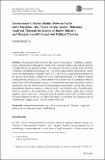Files in this item
International criminal justice between Scylla and Charybdis — the "peace versus justice" dilemma analysed through the lenses of Judith Shklar's and Hannah Arendt's legal and political theories
Item metadata
| dc.contributor.author | Royer, Christof | |
| dc.date.accessioned | 2017-12-08T15:30:08Z | |
| dc.date.available | 2017-12-08T15:30:08Z | |
| dc.date.issued | 2017-12 | |
| dc.identifier | 251246936 | |
| dc.identifier | 57d1ad6a-3f27-4615-95c6-0367c752161d | |
| dc.identifier | 85037038500 | |
| dc.identifier | 000416264100002 | |
| dc.identifier.citation | Royer , C 2017 , ' International criminal justice between Scylla and Charybdis — the "peace versus justice" dilemma analysed through the lenses of Judith Shklar's and Hannah Arendt's legal and political theories ' , Human Rights Review , vol. 18 , no. 4 , pp. 395-416 . https://doi.org/10.1007/s12142-017-0481-3 | en |
| dc.identifier.issn | 1524-8879 | |
| dc.identifier.uri | https://hdl.handle.net/10023/12300 | |
| dc.description.abstract | The present article discusses the “peace versus justice” dilemma in international criminal justice through the lenses of the respective legal (and political) theories of Judith Shklar and Hannah Arendt—two thinkers who have recently been described as theorists of international criminal law. The article claims that in interventions carried out by the International Criminal Court (ICC), there is an ever-present potentiality for the “peace versus justice” dilemma to occur. Unfortunately, there is no abstract solution to this problem, insofar as ICC interventions will in some cases be conducive while in others, they will be deleterious to peace. If a tension between peace and justice arises in a particular case, the article asserts, the former must be prioritised over the latter. Such a prioritisation, however, requires a vision of the ICC as a flexible actor of world politics which is situated at the intersection of law, ethics and politics, rather than a strictly legalistic view of the court. Ultimately, then, the present article seeks to probe whether the legal and political theories of Shklar and Arendt—in isolation, but ultimately also in combination—support such a flexible vision of the ICC. | |
| dc.format.extent | 575834 | |
| dc.language.iso | eng | |
| dc.relation.ispartof | Human Rights Review | en |
| dc.subject | International criminal court | en |
| dc.subject | "Peace versus justice" dilemma | en |
| dc.subject | Legal and political theory | en |
| dc.subject | Hannah Arendt | en |
| dc.subject | Judith Shklar | en |
| dc.subject | K Law | en |
| dc.subject | JC Political theory | en |
| dc.subject | JZ International relations | en |
| dc.subject | T-NDAS | en |
| dc.subject | SDG 16 - Peace, Justice and Strong Institutions | en |
| dc.subject.lcc | K | en |
| dc.subject.lcc | JC | en |
| dc.subject.lcc | JZ | en |
| dc.title | International criminal justice between Scylla and Charybdis — the "peace versus justice" dilemma analysed through the lenses of Judith Shklar's and Hannah Arendt's legal and political theories | en |
| dc.type | Journal article | en |
| dc.contributor.institution | University of St Andrews. School of International Relations | en |
| dc.contributor.institution | University of St Andrews. Institute of Legal and Constitutional Research | en |
| dc.identifier.doi | 10.1007/s12142-017-0481-3 | |
| dc.description.status | Peer reviewed | en |
This item appears in the following Collection(s)
Items in the St Andrews Research Repository are protected by copyright, with all rights reserved, unless otherwise indicated.

